#the amano shrimp cleaning crew
Text
any recommendations for a clean up crew for my aquarium once it's cycled? its a 10 gallon planted tank that will have 8-10 chili rasboras and partially blackwater/lower pH. i'm not sure exactly what the pH will be (botanicals have not arrived yet), probably around 6 if i had to guess?
i want to do blue velvet shrimp but i'm not sure how they'll do in the lower pH. i've heard that amanos could be better for lower pH, or just doing snails and providing them calcium in their food. i'm a total beginner so i'd love any advice/recommendations!! thx! 🐟🐟
36 notes
·
View notes
Text
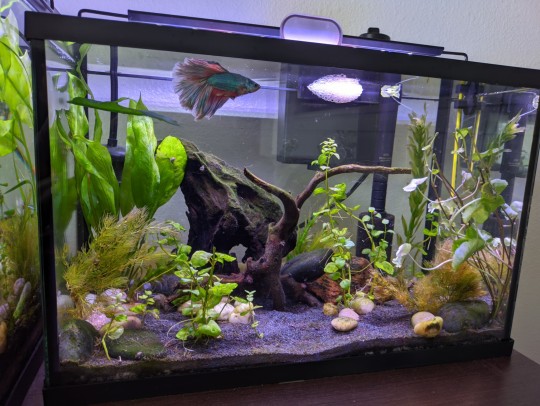

tanks update!!! added some plants yesterday, plinko got a pennywort, split some brazilian water weed in both, and my favorite is the fluffy plant i can't remember the name of i added for texture and continuity between tanks
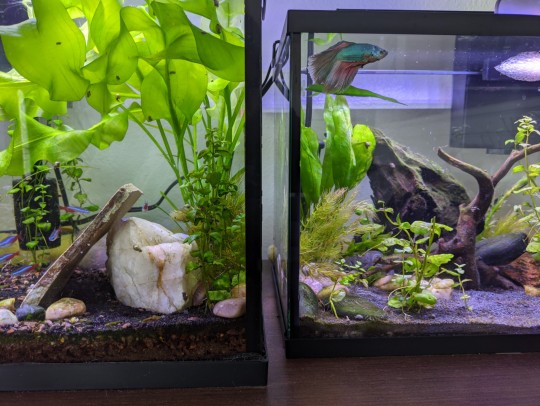
both tanks needed a lot of help after we got back from vacation so now we're fighting algae in both. plinko is doing amazing, he's such a chill confident guy, always checking out new stuff and movement without flaring, so i might see how he does with some ghost shrimp for a cleaning crew (I'd prefer fancy shrimp for that pop of color but ghost are cheap sooo)


one amano shrimp is WAY bigger than the other, makes me wonder if it's female

lil red had a split in his tail from several weeks ago, and i think it's still healing ok...? it's not as good as i want it but i think that's because of the overall hit the tanks took w/o us there for upkeep. he loves the new plant by his cave lol very much HIS territory
#fish tag#betta#scarlet badis#m2a#my pets#i worry so much about these little dudes#i unexpectedly lost a cory the other day which was one of the fish in the 10 from the beginning#the kh is slightly out of whack that's the only thing i can think of. adding alkaline buffer and stress guard for now#man...i do love this hobby 💛#the payoff of sitting next to beautiful plants and fish is so worth the work#fish
41 notes
·
View notes
Text
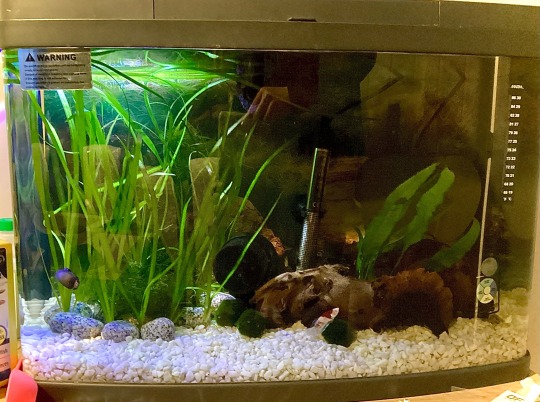
Plants are doing well! Once the second lamp arrives I can add some floating plants!
#betta fish#bettablr#fishblr#fish tank#hmpk#Zuko the betta fish#Garry the zebra snail#the amano shrimp cleaning crew#15gallon#the java ferns are still struggling tho#but the vallisneria are growing so fast!
7 notes
·
View notes
Note
Does Gabagool eat-clean the tank too like the other fish in the reblog?
Gabagool is a pleco catfish, yes he does clean the tank! I have a whole “bottom feeder” crew in my tank, lots of different species because bottom feeders are my favorites! Certain types of snails, catfish, and shrimp eat film algea off the tank and other algea off the plants. They also eat food waste. Gabagool mostly eats driftwood and veggies (he’s a vegetarian boi) and is definitely not as adepth at cleaning as my nerite snails and amano shrimps. Mostly because he flops.
The eel in my post is also a bottom feeder but literally is useless in terms of cleaning and just spazzes out. And the neon tetra don’t clean, they just chill.
Gabagool has a bigger ecosystem footprint than some other my other catfish (because his poop is too big), so you can only really have one pleco per tank. Common pleco can grow HUGE (3 feet!!) but thankfully Gabagool will stay around his current size. If you buy a pleco from Petsmart make sure it’s not a common pleco!! Cute but too big!
Gabagool has up until last week been timid and 100% nocturnal. Very scared of everything and would hide immediately if he was out from under his rock and I turned on the light. Recently he has been very floppy and active. My child is growing up!! Proud Mama.
17 notes
·
View notes
Text
Opae Ula Care
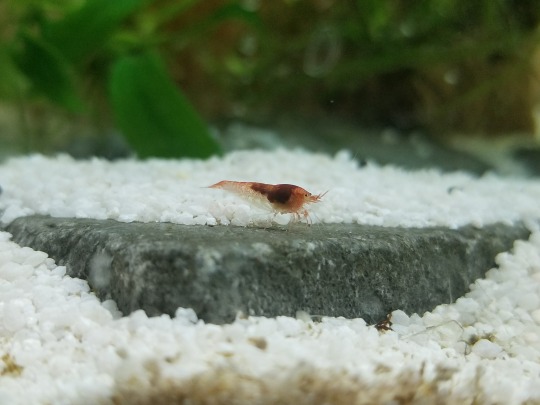
Introducing the tiny tank known as the Opae Ula or in scientific terms Halocaridina rubra. These shrimp are native to Hawaii typically found in anchialine pools, due to where they live they have evolved to survive harsh environments such as temperatures drops (30° f), low oxygen levels, no food for up to years, and extreme changes in salinity.
Sadly their hardy nature has allowed them to fall victim to Ecospheres or micro ecosystems which are enclosed (sometimes open) small spheres of stagnant water where these shrimp can be forced to endure many of the harsh environments addressed above for months to years.
Let's do these tiny shrimp some justice and give them a environment they can thrive in and not just survive in.
Scientific name: Halocaridina rubra
Common names: Red Hawaiian shrimp, opae ula, supershrimp, red shrimp, and volcano shrimp.
Care level: Beginner, due to their hardy nature these guys make a good introduction to shrimps and brackish tanks.
Water: These guys can live in freshwater, brackish, and even saltwater. However they truly thrive in brackish waters of 1.008-1.016 specific gravity or 11-21ppt.
Temperature: 75-85°F / 23-29°C.
Tank size: 5 gallons is the minimum for a group of these guys, but 10 gallons is heavily recommended as to make maintaining salinity and temperatures easier. When kept properly in these guys will easily breed so that’s something you’ll defiantly want to consider when choosing a tank size.
Size: 0.5" is the average size. Much smaller then most freshwater shrimp you'll see for sure!
Feeding: These guys are scavengers much like other species of shrimps and will eat a variety of foods such as pellets, algae wafers, veggies/leafy greens, etc. Currently I feed mine high quality pellets, algae wafers, spirulina and the occasional blanched zucchini and leafy greens.
Here are some articles that can give you a idea of what to feed, they are not made for opae ula most shrimp have the same tastes;
Planted Tank
Natural Pet care
Aquarium tidings
Filtration: Most care sheets are going to tell you to skip right past filtration and use the excuse “They prefer slow moving waters” or “It stresses them out” which is completely false. Well these guys can survive without a filter, they surely aren’t going to thrive in a tank without one. Like any tank they need a cycle of beneficial bacteria to help cycle out the bad stuff, but since they prefer slow moving waters you aren’t going to need anything very strong.
Personally I use a sponge filter in my tank, but I also have a weak power head to assist in preventing any dead spots in the tank and my shrimp don’t mind it.
When choosing a filter you’ll want to make sure your shrimp and baby shrimp aren’t going to get sucked into the intake so any filter then a sponge might need some modification.
*Cycling a brackish tank is very similar to cycling a freshwater tank, if your unfamiliar with cycling check this article out. Fishless cycle is preferred, but if your freeing yours from a ecosphere its better to do fish-in then leave then in the sphere.
Tank Mates: Since these shrimp are so tiny you aren’t going to be able to keep them with any fish since they’ll just become a snack to them. There are a few invert tank mates you can keep with your shrimp depending on the salinity you choose to keep yours in. Please research the specific invert and species you want before adding them to your tank, this is only a suggestion or to give you a idea of what you can stock!
Nerite Snails, these snails come in a variety of colors and sizes depending on the species you choose. Many thrive in brackish waters and can also live in freshwater, but keep in mind they also will breed in brackish water. 10g minimum.
Blue-legged Hermit crabs, tiny adorable hermit crabs commonly kept in saltwater tanks as a clean up crew can safely be kept with shrimp. They are mostly found in saltwater, but can also be found in high end brackish waters. 10g minimum.
Other snails, theres many other snails besides just the nerites that can be kept in brackish tanks like Malaysian trumpet snails(1.010), assassin snails(1.003), rabbit snails(1.003).
Other shrimp, if kept in freshwater or low brackish you can keep other species of shrimp like cherry shrimp(1.003) and amano shrimp(1.005).
Decor: These shrimp prefer lots of hiding spots and will be stressed if left out in the open. Using plants (in fresh or low brackish) is a attractive and easy way to provide your shrimp with cover. Here’s a good post on brackish tolerant plants!
Live rock is commonly used in saltwater tanks, but it can also be used in brackish tanks in a similar way. It provides lots of cover for your shrimp since it has lots of holes and crevasses for them to hide in. If you want to add a little green to your tank you can also use macro algae though! List of brackish tolerant macro algae here.
Water Changes: Many care sheets will tell you not to do water changes since it stresses them out, it is true it’ll stress them out, but it does not mean you should keep your shrimp in dirty water. A quick water change certainly isn’t going to kill them and a moment of stress for clean water is going to outweigh the downsides. Weekly or bi-weekly 25% water changes should be done on the tank. Personally I do mine bi-weekly since my tank is established and under stocked, I keep a eye on my water quality and do them before if needed.
Conclusion:
I hope this care sheet helped you guys out, if you have any questions or concerns feel free to shoot me a ask!
Also got a ecosphere and want to free your shrimp and give them a better life, but not sure how to crack that thing open safely? Check out this video! If you can’t watch the video I’ll give my best description:
On the bottom of the sphere there is a area where the sphere is sealed with a ring of silicone, carefully work around the silicone, and once you’ve worked that off pour the shrimp into a container.
*Also you are going to want to drip acclimate your shrimp to minimize stress and deaths.
Sources;
The Brackish Tank
Opae Ula UK (theres a lot to read here!)
Opae Ula Breeding (Opae Ula UK)
Opae Ula Care (Opae Ula UK)
Pet Shrimp
#opae ula#brackish#brackish tank#shrimpblr#shrimp#fishblr#aquablr#volcano shrimp#red shrimp#Hawaiian shrimp#red Hawaiian shrimp#how many stupid tags use I use before people get mad#ecosphere#fuck ecospheres#super shrimps#if you have a ecophere im going to break into your house break it and steal your shrimp#I had a ecosphere once and now I have over hundred shrimp and a 20g tank for them#tanks are prettier them hell orb
87 notes
·
View notes
Text
current livestock inventory
• 15 gallon planted aquarium: 10 Danio margaritatus (celestial pearl danio), 20-ish Corydoras pygmaeus (pygmy cory), 2 Trichopsis vittata (croaking gourami), 1 Caridina multidentata (Amano shrimp), Neocaridina davidi (cherry shrimp), assorted snails
• 7.5 gallon “pond tank”: 2 Cambarellus sp. (dwarf crayfish), Neocaridina davidi (cherry shrimp), Heterandria formosa (least killifish), assorted snails
• 12″x12″x18″ vivarium: 3 Lepidodactylus lugubris (mourning gecko), plus clean up crew – Folsomia candida (temperate springtails), Trichorhina tomentosa (dwarf white isopods), Porcellionides pruinosus (powder blue/white/orange isopods), Porcellio scaber 'Orange’
• other cultures: Porcellio laevis ‘Dairy Cow’, Porcellionides pruinosus (powder blue/white/orange isopods), Porcellio scaber 'Orange’, Armadillidium maculatum ‘Zebra’, Armadillidium klugii ‘Clown’
feel free to message me about the care and maintenance of any of these species, or if you just want to talk about them! :)
1 note
·
View note
Photo
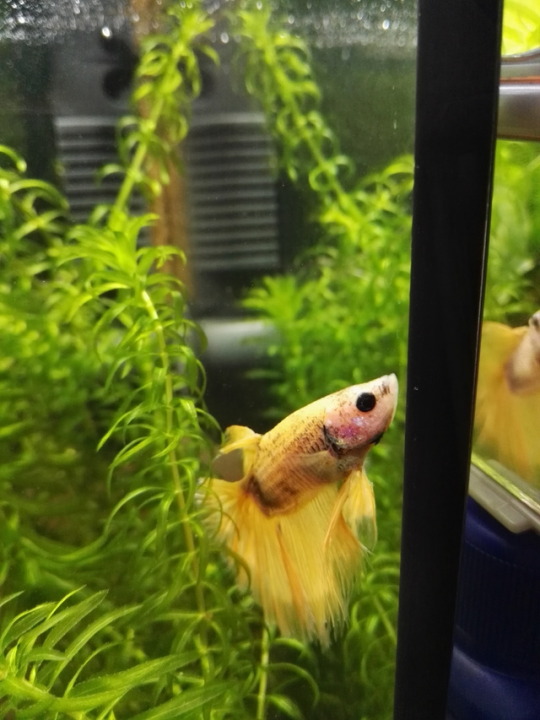
This pretty boy, I think he needs more stimulation. Also, I’d appreciate a little clean-up crew, because Johnny often leaves a mess after eating (TINYYY pieces) and the snails, besides pooping everywhere, only care for algae (which is great, but not quite enough, unfortunately). Also we’re developing a pond snail problem. I went through my options, thought about and did research on kuhli loaches, then forgot about it - the space is just not generous enough. Then I stumbled upon amano shrimp. Johnny is not very aggressive, flares hardly or not at all at his mirror self, only eats tiny pieces of food… And he mostly only uses half of his tank. This would make the situation ideal for Amanos and I would like to check them out tomorrow at the LFS. Has anybody had bad experience with amanos in betta tanks? I tried to research that too, but people say they only “attack” fish which are already dying - or that the Betta was the problem. My fiance LOVES shrimp so he’s pretty excited about the idea. I just want to make sure there are no unnecessary risks for John, who’s thriving by now. 😄
6 notes
·
View notes
Text
Which shrimp species are best for beginners? | 4 best starter shrimp
If you're just getting into shrimp keeping it's rather a little difficult to determine which type to start with.
There are therefore many species! So many colors, sizes and various requirements to choose from.
Some are difficult to care for and some are a breeze. Luckily, The Shrimp Farm can help.
Keep reading to discover the 4 best starter shrimp!
Red Cherry shrimp (Neocaridina davidi var. Red)
Crimson Cherry shrimp are most likely the most popular dwarf shrimp among both newbies and more capable shrimp keepers.
And for good reason! This crimson Neocaridina variety isn't too fussy about drinking water values, very easy to breed and quite decorative.
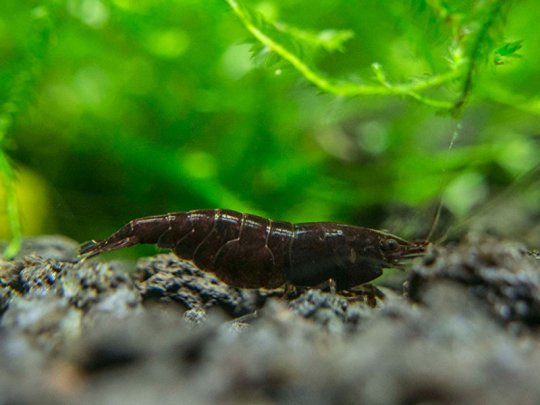
Colors may differ from a good light pink to deep blood red and with wise selective breeding you may easily improve the intensity.
Keep your Crimson Cherry shrimp in a fully cycled aquarium of at least around five gallons (19L).
If you're interested in breeding your Cherries a single species set up with only shrimp is recommended.
However, these shrimp also do well in tranquil community setups, as they breed rapidly and the occasional casualty won't damage the populace at all.
Provide your Crimson Cherries with a lot of hiding places, especially in community tanks, and feed a high quality shrimp food.
You can find a full Red Cherry shrimp caresheet at The Shrimp Farm here.
Amano shrimp (Caridina multidentata)
Amano shrimp are named after the late famous aquascaper Takashi Amano, who introduce them into the aquarium hobby on a huge scale first.
Though colorless and not too exciting to check out, these shrimp are among the most preferred because they're pretty hardy, have a huge appetite for algae and help to make an excellent cleaning crew.
They are a little bigger than dwarf shrimp but nonetheless entirely peaceful and an excellent addition to any calm community tank.
The just downside is they are almost impossible to breed in the home aquarium: they hatch as larvae which go through a brackish stage where they need a very specific amount of salt.
After that, they have to be returned to fresh water at exactly the right time.
Keep your Amano shrimp in a heated and cycled aquarium of at least around ten gallons (38L). As with all shrimp, provide plenty of hiding places in the sort of plants, rocks and driftwood.
If there is plenty of algae for the shrimp to eat you don't have to supplement their diet plan all that very much but be certain to always have some shrimp food on hand in case the algae run out.
You can locate a full Amano shrimp caresheet at The Shrimp Farm here.
Caridina Japonica Shrimp with eggs Caridina Japonica Shrimp with eggs by carolineccb
Blue Aspiration shrimp (Neocaridina davidi var. Blue)
Blue Dream shrimp certainly are a blue Neocaridina davidi variety: basically a blue version of Crimson Cherries.
Their care requirements are the same, they don't really need very certain water values and their striking color makes them a great eyecatcher in virtually any shrimp tank.
Like all shrimp they also make a good cleaning crew that keeps the aquarium tidy by eating leftover foods and algae.
They can be combined with small, relaxing fish species (provided there are a sufficient amount of hiding places) but show themselves more and breed of dog more readily within an invert-only setup with snails and other shrimp.
There are lots more Neocaridina davidi varieties out there, all of them simple to care for and a great breeding project for beginners.
Go for Blue Velvets if you are looking for a lighter blue color or possibly a bright Yellow! Just don't combine these shrimp in one aquarium; they do interbreed and any offspring will include a brownish wild color.
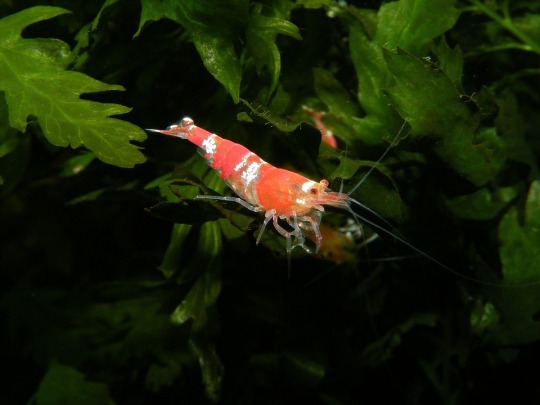
blue dream shrimp
Ghost shrimp (Palaemonetes sp.)
Ghost shrimp tend to be sold as cheap food for larger fish species but may also make an interesting everlasting addition to the aquarium.
They are on this list because they are incredibly hardy and can tolerate bad water values much better than most other shrimp. A great option if you're just getting started!
'Ghost shrimp' is a collective name for various shrimp species in the Palaemonetes genus, as a result be sure to buy from a reputable seller to avoid finding yourself with a huge aggressive river prawn or perhaps brackish variety.
The Shrimp Farm sells Palaemonetes paludosus, which doesn't grow too big and really should work fine in most cases. Hold your ghost shrimp in a cycled aquarium of at least around 10 gallons.
A calm community should work just fine (though keep in mind ghost shrimp could be slightly more aggressive than dwarf shrimp).
Ghost shrimp larvae are tiny and incredibly vulnerable, so if you're interested in breeding and do not want the youthful to finish up being eaten a good single-species setup may be the best idea.
Find out more info シュリンプ通販 Shrimp site
0 notes
Text
Which shrimp species are best for beginners? | 4 best starter shrimp
If you're just getting into shrimp keeping it's rather a little difficult to figure out which type to get started on with.
There are so many species! So many colors, sizes and different requirements to pick from.
Some are difficult to look after and some are a breeze. Fortunately, The Shrimp Farm might help.
Keep reading to find out the 4 best starter shrimp!
Crimson Cherry shrimp (Neocaridina davidi var. Red)
Red Cherry shrimp are probably the most famous dwarf shrimp among both newbies and more experienced shrimp keepers.
And for good reason! This reddish colored Neocaridina variety is not too fussy about water values, very easy to breed and quite ornamental.

Colors may differ from a good light pink to deep blood red and with wise selective breeding you can certainly improve the intensity.
Keep your Reddish colored Cherry shrimp in a completely cycled aquarium of for least around five gallons (19L).
If you're enthusiastic about breeding your Cherries a single species set up with only shrimp is recommended.
However, these shrimp do well in relaxing community setups also, as they breed rapidly and the casual casualty won't damage the populace at all.
Provide your Reddish colored Cherries with a lot of hiding places, especially in community tanks, and feed a high quality shrimp food.
You can discover a full Red Cherry shrimp caresheet at The Shrimp Farm here.
Amano shrimp (Caridina multidentata)
Amano shrimp are named after the late famous aquascaper Takashi Amano, who first introduce them into the aquarium hobby on a huge scale.
Though colorless rather than too exciting to look at, these shrimp are among the most favorite because they're pretty hardy, have an enormous appetite for algae and make a great cleaning crew.
They are a little bigger than dwarf shrimp but nonetheless entirely peaceful and an excellent addition to any peaceful community tank.
The just downside is that they are almost impossible to breed in the home aquarium: they hatch as larvae which go through a brackish stage where they desire a very particular amount of salt.
After that, they have to be returned to fresh water at precisely the right time.
Keep your Amano shrimp in a heated and cycled aquarium of at least around 10 gallons (38L). As with all shrimp, provide a lot of hiding locations in the kind of plants, driftwood and rocks.
If there is a lot of algae for the shrimp to eat you don't have to supplement their diet plan all that very much but make sure to will have some shrimp food readily available in case the algae go out.
You can locate a full Amano shrimp caresheet at The Shrimp Farm here.
Caridina Japonica Shrimp with eggs Caridina Japonica Shrimp with eggs by carolineccb
Blue Fantasy shrimp (Neocaridina davidi var. Blue)
Blue Dream shrimp are a blue Neocaridina davidi variety: basically a blue version of Crimson Cherries.
Their care requirements will be the same, they don't need very certain water values and their striking color makes them a great eyecatcher in virtually any shrimp tank.
Like all shrimp they also make a good cleaning crew that keeps the aquarium tidy by eating leftover foods and algae.
They can be combined with small, relaxing fish species (provided there are more than enough hiding places) but show themselves more and breed of dog more readily in an invert-only setup with snails and other shrimp.
There are more Neocaridina davidi varieties out there plenty, all of them simple to care for and a great breeding project for beginners.
Choose Blue Velvets if you're buying lighter blue color or maybe a bright Yellow! Only don't combine these shrimp in one aquarium; they carry out interbreed and any offspring will feature a brownish wild color.

blue dream shrimp
Ghost shrimp (Palaemonetes sp.)
Ghost shrimp are often sold as cheap foodstuff for larger seafood species but may also make a great interesting long lasting addition to the aquarium.
They are upon this list because they're incredibly hardy and will tolerate bad water values a lot better than most other shrimp. An excellent option if you are just getting started!
'Ghost shrimp' is a good collective name for various shrimp species in the Palaemonetes genus, as a result be sure to buy from an established seller to avoid ending up with an enormous aggressive river prawn or perhaps brackish variety.
The Shrimp Farm offers Palaemonetes paludosus, which doesn't grow too big and should work fine in most cases. Continue to keep your ghost shrimp in a cycled aquarium of at least around 10 gallons.
A calm community should work only fine (though bear in mind ghost shrimp can be slightly considerably more aggressive than dwarf shrimp).
Ghost shrimp larvae are actually tiny and very vulnerable, so if you're interested in breeding and do not want the little to end up being eaten a single-species setup could be the best idea.
Learn more info シュリンプ通販 Shrimp site
0 notes
Text
Which shrimp species are best for beginners? | 4 best starter shrimp
If you're just engaging in shrimp keeping it can be a little difficult to figure out which type to get started on with.
There are therefore many species! So various colors, sizes and various requirements to choose from.
Some are difficult to look after and some are a breeze. Thankfully, The Shrimp Farm might help.
Keep reading to find out the 4 very best starter shrimp!
Red Cherry shrimp (Neocaridina davidi var. Red)
Red Cherry shrimp are most likely the most popular dwarf shrimp among both beginners and more capable shrimp keepers.
And once and for all reason! This crimson Neocaridina variety isn't too fussy about drinking water values, very simple to breed and quite ornamental.
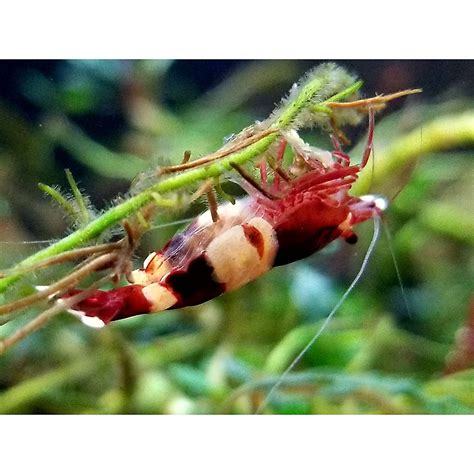
Colors can vary from a good light pink to deep blood vessels red and with smart selective breeding you can simply improve the intensity.
Keep your Reddish Cherry shrimp in a fully cycled aquarium of at least around five gallons (19L).
If you're considering breeding your Cherries a single species set up with only shrimp is preferred.
However, these shrimp do well in tranquil community setups also, as they breed rapidly and the casual casualty won't damage the population at all.
Provide your Reddish colored Cherries with a good amount of hiding places, in community tanks especially, and feed a top quality shrimp food.
You can discover a full Red Cherry shrimp caresheet at The Shrimp Farm here.
Amano shrimp (Caridina multidentata)
Amano shrimp are named after the late famous aquascaper Takashi Amano, who introduce them into the aquarium hobby on a big scale first.
Though colorless and not too exciting to check out, these shrimp are among the most preferred because they are pretty hardy, have an enormous appetite for algae and get an excellent cleaning crew.
They are a little larger than dwarf shrimp but nonetheless entirely peaceful and a great addition to any peaceful community tank.
The just downside is that they are almost impossible to breed in the home aquarium: they hatch as larvae which proceed through a brackish level where they need a very particular amount of salt.
After that, they need to be returned to fresh water at accurately the proper time.
Keep your Amano shrimp in a heated and cycled aquarium of by least around ten gallons (38L). As with all shrimp, provide a lot of hiding areas in the sort of plants, rocks and driftwood.
If there is lots of algae for the shrimp to eat you don't need to supplement their diet plan all that much but make certain to always have some shrimp food on hand in case the algae go out.
You can look for a full Amano shrimp caresheet at The Shrimp Farm here.
Caridina Japonica Shrimp with eggs Caridina Japonica Shrimp with eggs by carolineccb
Blue Fantasy shrimp (Neocaridina davidi var. Blue)
Blue Dream shrimp are a blue Neocaridina davidi variety: basically a blue version of Red Cherries.
Their care requirements will be the same, they don't really need very specific water values and their striking color makes them an excellent eyecatcher in any shrimp tank.
Like all shrimp in addition they make an excellent cleaning crew that keeps the aquarium tidy by eating leftover foods and algae.
They can be coupled with small, relaxing fish species (provided there are plenty of hiding places) but show themselves more and breed more readily in an invert-only setup with snails and other shrimp.
There are lots more Neocaridina davidi varieties out there, all of them easy to care for and a great breeding project for beginners.
Go for Blue Velvets if you are looking for a lighter blue color or maybe a bright Yellow! Only don't incorporate these shrimp in one aquarium; they carry out interbreed and any offspring will feature a brownish wild color.
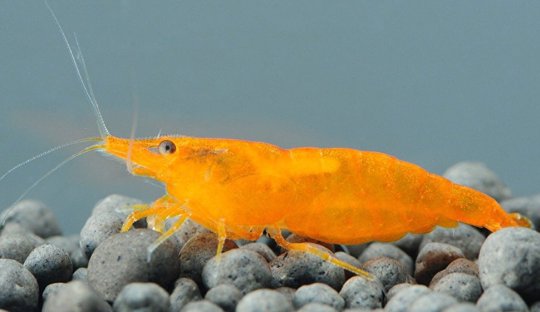
blue dream shrimp
Ghost shrimp (Palaemonetes sp.)
Ghost shrimp are often sold as cheap meals for larger fish species but may also make a great interesting long lasting addition to the aquarium.
They are upon this list because they are incredibly hardy and may tolerate bad water values a lot better than most other shrimp. A great option if you are just getting started!
'Ghost shrimp' is a good collective name for various shrimp species found in the Palaemonetes genus, as a result be sure to purchase from an established seller to avoid ending up with an enormous aggressive river prawn or brackish variety.
The Shrimp Farm sells Palaemonetes paludosus, which doesn't grow too large and should work fine in most cases. Maintain your ghost shrimp in a cycled aquarium of at least around 10 gallons.
A calm community should work simply fine (though take into account ghost shrimp can be slightly more aggressive than dwarf shrimp).
Ghost shrimp larvae are tiny and incredibly vulnerable, so if you're interested in breeding and don't want the little to wrap up being eaten a single-species setup could be the best idea.
Find out more info シュリンプ通販 Shrimp site
0 notes
Text
Which shrimp species are best for beginners? | 4 best starter shrimp
If you're just getting into shrimp keeping it can be a little difficult to figure out which type to get started on with.
There are consequently many species! So various colors, sizes and various requirements available.
Some are difficult to look after and some are a breeze. Fortunately, The Shrimp Farm might help.
Keep reading to determine the 4 finest starter shrimp!
Crimson Cherry shrimp (Neocaridina davidi var. Red)
Crimson Cherry shrimp are probably the most used dwarf shrimp among both beginners and more experienced shrimp keepers.
And once and for all reason! This reddish colored Neocaridina variety isn't too fussy about water values, very simple to breed and quite ornamental.
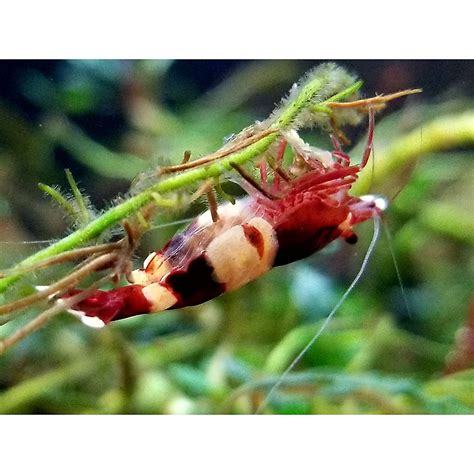
Colors may differ from a light pink to deep blood red and with wise selective breeding you can certainly improve the intensity.
Keep your Reddish Cherry shrimp in a fully cycled aquarium of for least around five gallons (19L).
If you're interested in breeding your Cherries a single species setup with only shrimp is preferred.
However, these shrimp also do well in tranquil community setups, as they breed very quickly and the casual casualty won't damage the populace at all.
Provide your Crimson Cherries with a lot of hiding places, especially in community tanks, and feed a top quality shrimp food.
You can locate a full Red Cherry shrimp caresheet at The Shrimp Farm here.
Amano shrimp (Caridina multidentata)
Amano shrimp are named after the past due famous aquascaper Takashi Amano, who introduce them into the aquarium hobby on a big scale first.
Though colorless rather than too exciting to check out, these shrimp are being among the most favorite because they are pretty hardy, have a huge appetite for algae and get an excellent cleaning crew.
They are a little larger than dwarf shrimp but still entirely peaceful and a great addition to any relaxing community tank.
The just downside is that they are almost impossible to breed of dog in the home aquarium: they hatch as larvae which proceed through a brackish stage where they need a very particular amount of salt.
After that, they have to be returned to fresh water at accurately the proper time.
Keep the Amano shrimp in a heated and cycled aquarium of for least around ten gallons (38L). As with all shrimp, provide a good amount of hiding areas in the kind of plants, driftwood and rocks.
If there is a lot of algae for the shrimp to consume you don't have to supplement their diet plan all that very much but make sure to always have some shrimp food readily available in the event the algae go out.
You can look for a full Amano shrimp caresheet at The Shrimp Farm here.
Caridina Japonica Shrimp with eggs Caridina Japonica Shrimp with eggs by carolineccb
Blue Dream shrimp (Neocaridina davidi var. Blue)
Blue Dream shrimp are a blue Neocaridina davidi variety: basically a blue version of Crimson Cherries.
Their care requirements will be the same, they don't really need very particular water values and their striking color makes them an excellent eyecatcher in any shrimp tank.
Like all shrimp in addition they make an excellent cleaning crew that keeps the aquarium tidy by eating leftover foods and algae.
They can be coupled with small, tranquil fish species (provided there are enough hiding places) but show themselves more and breed of dog more readily in an invert-only setup with snails and other shrimp.
There are lots more Neocaridina davidi varieties out there, all of them easy to care for and an excellent breeding project for beginners.
Choose Blue Velvets if you're buying lighter blue color or possibly a bright Yellow! Simply don't incorporate these shrimp in a single aquarium; they do interbreed and any offspring will include a brownish wild color.
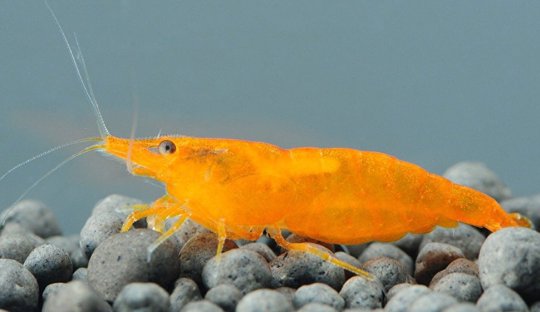
blue dream shrimp
Ghost shrimp (Palaemonetes sp.)
Ghost shrimp are often sold as cheap meals for larger seafood species but may also make an interesting long lasting addition to the aquarium.
They are upon this list because they are incredibly hardy and may tolerate bad water values much better than most other shrimp. A great option if you're just getting started!
'Ghost shrimp' is a collective brand for various shrimp species in the Palaemonetes genus, as a result be sure to purchase from an established seller to avoid ending up with an enormous aggressive river prawn or perhaps brackish variety.
The Shrimp Farm offers Palaemonetes paludosus, which doesn't grow too big and should work fine in most cases. Maintain your ghost shrimp in a cycled aquarium of at least around 10 gallons.
A tranquil community should work just fine (though remember ghost shrimp could be slightly considerably more aggressive than dwarf shrimp).
Ghost shrimp larvae are actually tiny and very vulnerable, so if you're interested found in breeding and don't want the little to wrap up being eaten a good single-species setup could be the best idea.
Get more information info シュリンプ Shrimp
0 notes
Text
Which shrimp species are best for beginners? | 4 best starter shrimp
If you're just getting into shrimp keeping it's rather a little difficult to figure out which type to begin with.
There are so many species! So various colors, sizes and different requirements to choose from.
Some are difficult to care for and some are a breeze. Thankfully, The Shrimp Farm can help.
Keep reading to discover the 4 most effective starter shrimp!
Red Cherry shrimp (Neocaridina davidi var. Red)
Red Cherry shrimp are probably the most famous dwarf shrimp among both beginners and more capable shrimp keepers.
And once and for all reason! This crimson Neocaridina variety is not too fussy about normal water values, very easy to breed and quite ornamental.
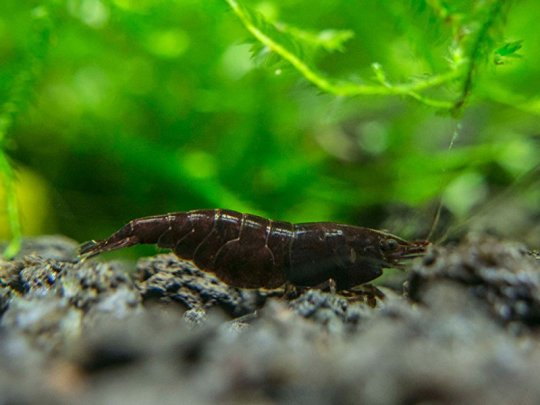
Colors can vary from a good light pink to deep blood red and with smart selective breeding you may easily improve the intensity.
Keep your Crimson Cherry shrimp in a completely cycled aquarium of in least around five gallons (19L).
If you're interested in breeding your Cherries an individual species set up with only shrimp is recommended.
However, these shrimp also do well in peaceful community setups, as they breed very quickly and the casual casualty won't damage the populace at all.
Provide your Reddish Cherries with plenty of hiding places, especially in community tanks, and feed a top quality shrimp food.
You can find a full Red Cherry shrimp caresheet at The Shrimp Farm here.
Amano shrimp (Caridina multidentata)
Amano shrimp are named after the later famous aquascaper Takashi Amano, who introduce them into the aquarium hobby on a big scale first.
Though colorless and not too exciting to check out, these shrimp are being among the most common because they're pretty hardy, have an enormous appetite for algae and make an excellent cleaning crew.
They certainly are a little bigger than dwarf shrimp but nonetheless entirely peaceful and an excellent addition to any tranquil community tank.
The just downside is that they are almost impossible to breed of dog in the home aquarium: they hatch as larvae which go through a brackish stage where they desire a very specific amount of salt.
After that, they have to be returned to fresh water at specifically the right time.
Keep your Amano shrimp in a heated and cycled aquarium of by least around 10 gallons (38L). As with all shrimp, provide a good amount of hiding spots in the form of plants, rocks and driftwood.
If there is a good amount of algae for the shrimp to consume you don't have to supplement their diet all that very much but make sure to always have some shrimp food on hand in case the algae run out.
You can discover a full Amano shrimp caresheet at The Shrimp Farm here.
Caridina Japonica Shrimp with eggs Caridina Japonica Shrimp with eggs by carolineccb
Blue Aspiration shrimp (Neocaridina davidi var. Blue)
Blue Dream shrimp certainly are a blue Neocaridina davidi variety: basically a blue version of Red Cherries.
Their care requirements will be the same, they don't really need very specific water values and their impressive color makes them a great eyecatcher in any shrimp tank.
Like all shrimp they also make a good cleaning crew that keeps the aquarium tidy by consuming leftover foods and algae.
They can be coupled with small, calm fish species (provided there are plenty of hiding places) but show themselves more and breed of dog more readily within an invert-only setup with snails and other shrimp.
There are plenty more Neocaridina davidi varieties out there, all of them easy to care for and an excellent breeding project for beginners.
Go for Blue Velvets if you are buying a lighter blue color or possibly a bright Yellow! Merely don't combine these shrimp in a single aquarium; they carry out interbreed and any offspring will include a brownish wild color.
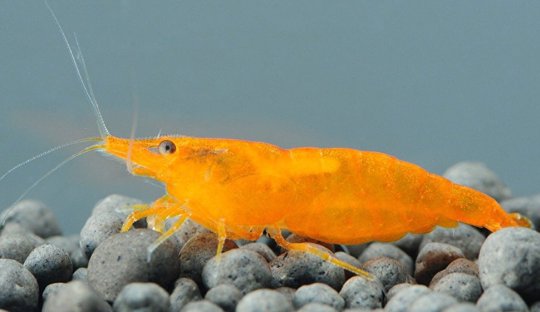
blue dream shrimp
Ghost shrimp (Palaemonetes sp.)
Ghost shrimp are often sold as cheap foodstuff for larger fish species but can also make an interesting long lasting addition to the aquarium.
They are on this list because they're incredibly hardy and will tolerate bad water values a lot better than most other shrimp. A great option if you're just getting started!
'Ghost shrimp' is a collective brand for various shrimp species in the Palaemonetes genus, so be sure to buy from a reputable seller to avoid ending up with a huge aggressive river prawn or perhaps brackish variety.
The Shrimp Farm offers Palaemonetes paludosus, which doesn't grow too big and should work fine in most cases. Continue to keep your ghost shrimp in a cycled aquarium of at least around 10 gallons.
A relaxing community should work only fine (though bear in mind ghost shrimp can be slightly considerably more aggressive than dwarf shrimp).
Ghost shrimp larvae are actually tiny and very vulnerable, so if you are interested found in breeding and do not want the fresh to end up being eaten a single-species setup might be the best idea.
Learn more info シュリンプ Shrimp
0 notes
Photo
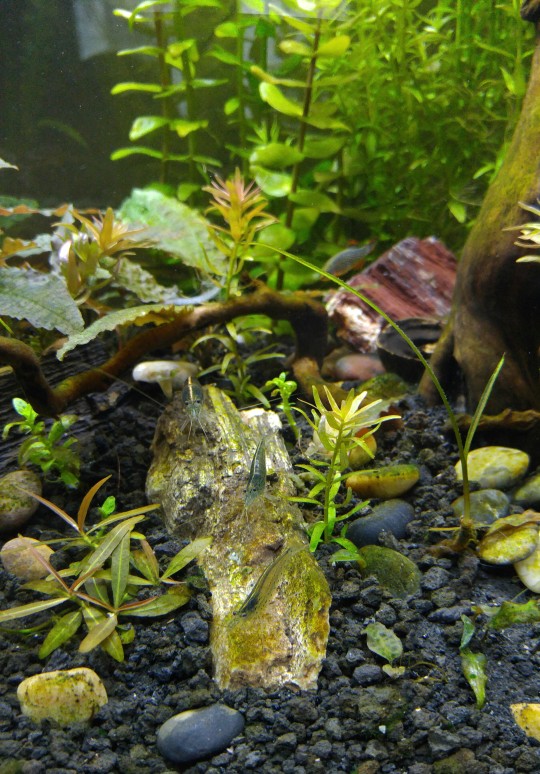
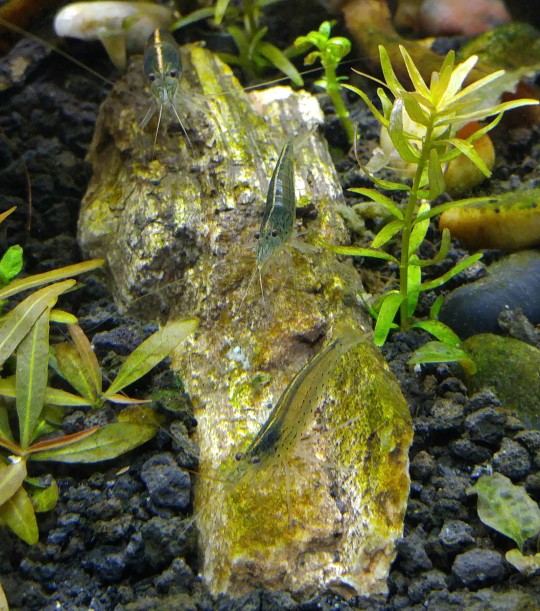
Amano Shrimp cleaning crew
7 notes
·
View notes
Text
Which shrimp species are best for beginners? | 4 best starter shrimp
If you're just getting into shrimp keeping it can be a little difficult to figure out which type to get started on with.
There are so many species! So various colors, sizes and different requirements to choose from.
Some are difficult to look after and some are a breeze. Luckily, The Shrimp Farm can help.
Keep reading to determine the 4 very best starter shrimp!
Red Cherry shrimp (Neocaridina davidi var. Red)
Red Cherry shrimp are most likely the most popular dwarf shrimp among both newbies and more capable shrimp keepers.
And once and for all reason! This reddish colored Neocaridina variety isn't too fussy about water values, very easy to breed and quite attractive.

Colors can vary from a good light pink to deep blood vessels red and with smart selective breeding you may easily improve the intensity.
Keep your Red Cherry shrimp in a fully cycled aquarium of for least around five gallons (19L).
If you're interested in breeding your Cherries a single species setup with only shrimp is recommended.
However, these shrimp also do well in relaxing community setups, as they breed very quickly and the casual casualty won't damage the population at all.
Provide your Crimson Cherries with plenty of hiding places, in community tanks especially, and feed a high quality shrimp food.
You can look for a full Red Cherry shrimp caresheet at The Shrimp Farm here.
Amano shrimp (Caridina multidentata)
Amano shrimp are named after the later famous aquascaper Takashi Amano, who first introduce them into the aquarium hobby on a large scale.
Though colorless rather than too exciting to look at, these shrimp are among the most preferred because they are pretty hardy, have a huge appetite for algae and make a great cleaning crew.
They are a little bigger than dwarf shrimp but nonetheless entirely peaceful and an excellent addition to any calm community tank.
The only downside is they are almost impossible to breed in the house aquarium: they hatch as larvae which go through a brackish level where they desire a very specific amount of salt.
After that, they need to be returned to fresh water at specifically the right time.
Keep the Amano shrimp in a heated and cycled aquarium of at least around ten gallons (38L). Much like all shrimp, provide lots of hiding places in the kind of plants, rocks and driftwood.
If there is a lot of algae for the shrimp to eat you don't need to supplement their diet plan all that much but make certain to always have some shrimp food readily available in the event the algae run out.
You can find a full Amano shrimp caresheet at The Shrimp Farm here.
Caridina Japonica Shrimp with eggs Caridina Japonica Shrimp with eggs by carolineccb
Blue Wish shrimp (Neocaridina davidi var. Blue)
Blue Dream shrimp are a blue Neocaridina davidi variety: basically a blue version of Red Cherries.
Their care requirements will be the same, they don't need very particular water values and their striking color makes them an excellent eyecatcher in virtually any shrimp tank.
Like all shrimp in addition they make a good cleaning crew that keeps the aquarium tidy by eating leftover foods and algae.
They can be combined with small, relaxing fish species (provided there are plenty of hiding places) but show themselves more and breed of dog more readily within an invert-only setup with snails and other shrimp.
There are more Neocaridina davidi varieties out there lots, all of them easy to care for and an excellent breeding project for beginners.
Choose Blue Velvets if you're looking for a lighter blue color or possibly a bright Yellow! Merely don't incorporate these shrimp in one aquarium; they carry out interbreed and any offspring will include a brownish wild color.

blue dream shrimp
Ghost shrimp (Palaemonetes sp.)
Ghost shrimp are often sold as cheap foodstuff for larger seafood species but can also make an interesting everlasting addition to the aquarium.
They are upon this list because they are incredibly hardy and will tolerate bad water values a lot better than most other shrimp. A great option if you're just getting started!
'Ghost shrimp' is a good collective brand for various shrimp species in the Palaemonetes genus, thus be sure to purchase from an established seller to avoid ending up with an enormous aggressive river prawn or perhaps brackish variety.
The Shrimp Farm markets Palaemonetes paludosus, which doesn't grow too large and really should work fine generally. Continue to keep your ghost shrimp in a cycled aquarium of at least around 10 gallons.
A relaxing community should work only fine (though bear in mind ghost shrimp can be slightly considerably more aggressive than dwarf shrimp).
Ghost shrimp larvae are tiny and very vulnerable, so if you're interested found in breeding and do not want the young to finish up being eaten a good single-species setup could possibly be the best idea.
Get more information info シュリンプ通販 Shrimp site
0 notes
Text
Which shrimp species are best for beginners? | 4 best starter shrimp
If you're just getting into shrimp keeping it's rather a little difficult to figure out which type to begin with.
There are therefore many species! So various colors, sizes and different requirements from which to choose.
Some are difficult to look after and some are super easy. Luckily, The Shrimp Farm can help.
Keep reading to determine the 4 finest starter shrimp!
Red Cherry shrimp (Neocaridina davidi var. Red)
Crimson Cherry shrimp are most likely the most used dwarf shrimp among both starters and more capable shrimp keepers.
And for good reason! This reddish colored Neocaridina variety is not too fussy about normal water values, very easy to breed and quite attractive.

Colors can vary from a good light pink to deep blood red and with smart selective breeding you can certainly improve the intensity.
Keep your Reddish colored Cherry shrimp in a fully cycled aquarium of by least around five gallons (19L).
If you're interested in breeding your Cherries an individual species set up with only shrimp is recommended.
However, these shrimp also do well in tranquil community setups, as they breed rapidly and the occasional casualty won't damage the populace at all.
Provide your Red Cherries with plenty of hiding places, especially in community tanks, and feed a high quality shrimp food.
You can locate a full Red Cherry shrimp caresheet at The Shrimp Farm here.
Amano shrimp (Caridina multidentata)
Amano shrimp are named after the past due famous aquascaper Takashi Amano, who first introduce them into the aquarium hobby on a big scale.
Though colorless rather than too exciting to look at, these shrimp are being among the most common because they're pretty hardy, have an enormous appetite for algae and make an excellent cleaning crew.
They are a little larger than dwarf shrimp but nonetheless entirely peaceful and an excellent addition to any relaxing community tank.
The just downside is they are almost impossible to breed of dog in the house aquarium: they hatch as larvae which proceed through a brackish level where they desire a very particular amount of salt.
After that, they need to be returned to fresh water at specifically the right time.
Keep your Amano shrimp in a heated and cycled aquarium of in least around ten gallons (38L). Much like all shrimp, provide a lot of hiding spots in the sort of plants, rocks and driftwood.
If there is plenty of algae for the shrimp to consume you don't need to supplement their diet all that much but make certain to will have some shrimp food readily available in case the algae run out.
You can look for a full Amano shrimp caresheet at The Shrimp Farm here.
Caridina Japonica Shrimp with eggs Caridina Japonica Shrimp with eggs by carolineccb
Blue Goal shrimp (Neocaridina davidi var. Blue)
Blue Dream shrimp certainly are a blue Neocaridina davidi variety: basically a blue version of Crimson Cherries.
Their care requirements will be the same, they don't need very certain water values and their impressive color makes them a great eyecatcher in any shrimp tank.
Like all shrimp in addition they make an excellent cleaning crew that keeps the aquarium tidy by eating leftover foods and algae.
They can be combined with small, peaceful fish species (provided there are more than enough hiding places) but show themselves more and breed of dog more readily within an invert-only setup with snails and other shrimp.
There are more Neocaridina davidi varieties out there lots, all of them simple to care for and a great breeding project for beginners.
Choose Blue Velvets if you are buying lighter blue color or possibly a bright Yellow! Merely don't combine these shrimp in one aquarium; they carry out interbreed and any offspring will include a brownish wild color.

blue dream shrimp
Ghost shrimp (Palaemonetes sp.)
Ghost shrimp tend to be sold as cheap meals for larger seafood species but can also make an interesting long lasting addition to the aquarium.
They are on this list because they're incredibly hardy and may tolerate bad water values much better than most other shrimp. A great option if you are just getting started!
'Ghost shrimp' is a good collective name for various shrimp species in the Palaemonetes genus, thus be sure to purchase from a reputable seller to avoid ending up with a huge aggressive river prawn or brackish variety.
The Shrimp Farm sells Palaemonetes paludosus, which doesn't grow too large and really should work fine generally. Continue to keep your ghost shrimp in a cycled aquarium of at least around 10 gallons.
A relaxing community should work just fine (though bear in mind ghost shrimp could be slightly more aggressive than dwarf shrimp).
Ghost shrimp larvae are tiny and very vulnerable, so if you are interested in breeding and do not want the fresh to finish up being eaten a good single-species setup could possibly be the best idea.
Learn more info シュリンプ Shrimp
0 notes
Text
Which shrimp species are best for beginners? | 4 best starter shrimp
If you're just getting into shrimp keeping it's rather a little difficult to determine which type to get started on with.
There are hence many species! So various colors, sizes and various requirements to select from.
Some are difficult to care for and some are super easy. Fortunately, The Shrimp Farm can help.
Keep reading to learn the 4 most effective starter shrimp!
Red Cherry shrimp (Neocaridina davidi var. Red)
Red Cherry shrimp are probably the most popular dwarf shrimp among both starters and more experienced shrimp keepers.
And for good reason! This red Neocaridina variety is not too fussy about water values, very simple to breed and quite ornamental.
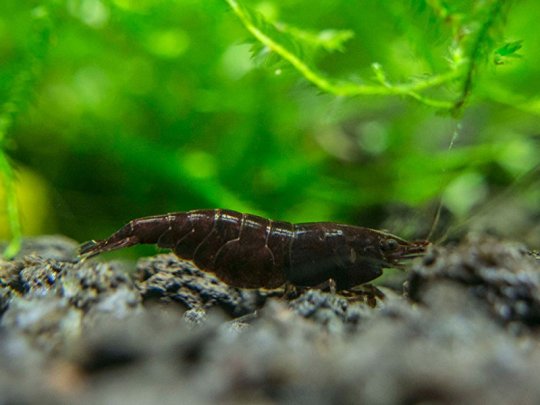
Colors may differ from a good light pink to deep blood red and with good selective breeding you can easily improve the intensity.
Keep your Red Cherry shrimp in a completely cycled aquarium of by least around five gallons (19L).
If you're interested in breeding your Cherries an individual species set up with only shrimp is preferred.
However, these shrimp do well in relaxing community setups also, as they breed rapidly and the casual casualty won't damage the populace at all.
Provide your Reddish Cherries with plenty of hiding places, especially in community tanks, and feed a top quality shrimp food.
You can discover a full Red Cherry shrimp caresheet at The Shrimp Farm here.
Amano shrimp (Caridina multidentata)
Amano shrimp are named after the later famous aquascaper Takashi Amano, who first introduce them into the aquarium hobby on a sizable scale.
Though colorless rather than too exciting to check out, these shrimp are being among the most famous because they're pretty hardy, have a huge appetite for algae and make a great cleaning crew.
They are a little bigger than dwarf shrimp but still entirely peaceful and an excellent addition to any tranquil community tank.
The simply downside is that they are almost impossible to breed in the home aquarium: they hatch as larvae which go through a brackish stage where they need a very particular amount of salt.
After that, they have to be returned to fresh water at exactly the proper time.
Keep your Amano shrimp in a heated and cycled aquarium of at least around ten gallons (38L). As with all shrimp, provide a good amount of hiding areas in the kind of plants, driftwood and rocks.
If there is a lot of algae for the shrimp to eat you don't need to supplement their diet plan all that substantially but be sure to will have some shrimp food on hand in case the algae go out.
You can discover a full Amano shrimp caresheet at The Shrimp Farm here.
Caridina Japonica Shrimp with eggs Caridina Japonica Shrimp with eggs by carolineccb
Blue Wish shrimp (Neocaridina davidi var. Blue)
Blue Dream shrimp certainly are a blue Neocaridina davidi variety: basically a blue version of Red Cherries.
Their care requirements are the same, they don't really need very specific water values and their impressive color makes them an excellent eyecatcher in any shrimp tank.
Like all shrimp they also make a good cleaning crew that keeps the aquarium tidy by eating leftover foods and algae.
They can be coupled with small, peaceful fish species (provided there are plenty of hiding places) but show themselves more and breed of dog more readily within an invert-only setup with snails and other shrimp.
There are plenty more Neocaridina davidi varieties out there, all of them simple to care for and an excellent breeding project for beginners.
Go for Blue Velvets if you are buying lighter blue color or possibly a bright Yellow! Simply don't incorporate these shrimp in a single aquarium; they do interbreed and any offspring will include a brownish wild color.

blue dream shrimp
Ghost shrimp (Palaemonetes sp.)
Ghost shrimp tend to be sold as cheap foodstuff for larger fish species but may also make an interesting everlasting addition to the aquarium.
They are upon this list because they are incredibly hardy and can tolerate bad water values much better than most other shrimp. A great option if you are just getting started!
'Ghost shrimp' is a good collective brand for various shrimp species found in the Palaemonetes genus, as a result be sure to buy from a reputable seller to avoid ending up with a huge aggressive river prawn or brackish variety.
The Shrimp Farm offers Palaemonetes paludosus, which doesn't grow too big and really should work fine in most cases. Keep your ghost shrimp in a cycled aquarium of at least around 10 gallons.
A tranquil community should work only fine (though bear in mind ghost shrimp can be slightly more aggressive than dwarf shrimp).
Ghost shrimp larvae are tiny and very vulnerable, so if you are interested in breeding and don't want the fresh to wrap up being eaten a good single-species setup could be the best idea.
Learn more info シュリンプ通販 Shrimp site
0 notes